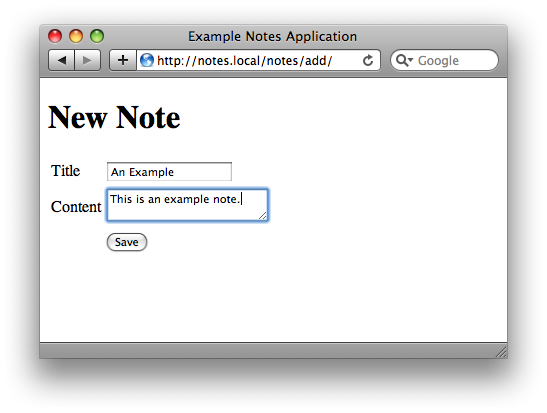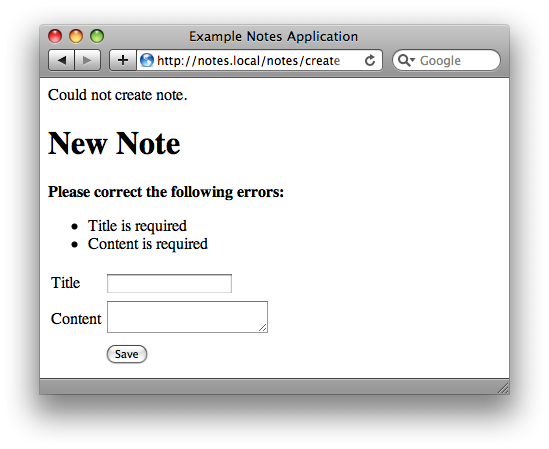
Tutorial
Quick Start Example
Install It
The best way to get Critical I is to use the installer. Download it from http://criticali.missioncriticallabs.com/get-criticali. Save the file as get-criticali.php and then run it with the command:
$ php get-criticali.php
Get The Packages You'll Need
Once you install Critical I, you'll have an empty repository. The repository is for storing packages you want to add to projects. For this exercise, we'll need to download a few packages for a simple project. We can grab everything we need with the command:
$ criticali add --yes mvc
To get more information about any of the available criticali commands, type "criticali help command" at the command line or "criticali help commands" to see a list of commands.
Create A Project
The next step is to create a new, empty project (web application). Again, from my home directory:
$ criticali project-init notes
Then, inside the project, add the MVC framework:
$ cd notes
$ criticali project-add mvc
This command "freezes" the library components we're using (in this case, the MVC components) inside our project directory so that deployment is simply a matter of copying the directory up to the server. Critical I provides commands for managing the library components that are part of a project.
Setup The Database
I'll use a migration to create the database table for my application. Once again using my favorite text editor, I'll create the file private/migrations/001_CreateNotesTableMigration.php with the content:
<?php
class CreateNotesTableMigration extends Migration_Base {
public function up () {
$this->exec("
CREATE TABLE notes (
id INTEGER NOT NULL PRIMARY KEY AUTOINCREMENT,
title varchar(255) NOT NULL,
content text NOT NULL
)
");
}
public function down() {
$this->exec("DROP TABLE notes");
}
}
?>
And then I'll run it:
$ criticali project-migrate
Create The Model
I need a model for my notes table. It's declared in a new file in private/models/Note.php. The code is:
<?php
class Note extends ActiveRecord_Base {
}
?>
Create The Controller
Now I'll create my controller for basic notes operations. The controller goes in private/controllers/NotesController.php and looks like:
<?php
class NotesController extends Controller_Base {
public function index() {
$this->notes = $this->model('Note')->find_all();
}
public function add() {
$this->note = new Note();
}
public function create() {
$this->note = new Note($_POST['note']);
if ($this->note->save()) {
$this->set_flash('notice', 'Note created.');
$this->redirect_to('/notes');
} else {
$this->set_flash('notice', 'Could not create note.');
$this->render_action(array('action'=>'add'));
}
}
public function edit() {
$this->note = $this->model('Note')->find($_REQUEST['id']);
}
public function update() {
$this->note = $this->model('Note')->find($_REQUEST['id']);
if ($this->note->update_attributes($_POST['note'])) {
$this->set_flash('notice', 'Note updated.');
$this->redirect_to('/notes');
} else {
$this->set_flash('notice', 'Could not update note.');
$this->render_action(array('action'=>'edit'));
}
}
public function delete() {
$this->note = $this->model('Note')->find($_REQUEST['id']);
$this->note->destroy();
$this->set_flash('notice', 'Note deleted.');
$this->redirect_to('/notes');
}
}
?>
Create The Views
Lastly, we'll need several view files. To keep this example easy to understand, I'll stick to simple and straightforward HTML. Prettying it up a bit and following better development conventions (for example, posting delete requests) can be left as an exercise for the reader.
By default, the Critical I MVC framework uses Smarty templates. The view for each action in a controller is a separate file in a folder named for the controller all inside of private/views. So, getting right to the point, I'll create private/views/notes/index.tpl:
<h1>List of Notes</h1>
<table>
<thead>
<tr>
<th>Action</th>
<th>Title</th>
</tr>
</thead>
<tbody>
{foreach from=$notes item=note}
<tr>
<td><a href="/notes/edit/{$note->id|escape}">edit</a>
<a href="/notes/delete/{$note->id|escape}">delete</a></td>
<td>{$note->title|escape}</td>
</tr>
{/foreach}
</tbody>
</table>
<p><a href="/notes/add/">Add New</a></p>
Then on to private/views/notes/add.tpl:
<h1>New Note</h1>
{errors for=$note}
<form action="/notes/create" method="post">
{include file="notes/_form_fields.tpl"}
</form>
And the referenced private/views/notes/_form_fields.tpl:
<table>
<tr>
<td><label for="note_title">Title</label></td>
<td>{text_field var="note" attr="title"}</td>
</tr>
<tr>
<td><label for="note_content">Content</label></td>
<td>{text_area var="note" attr="content"}</td>
</tr>
<tr>
<td> </td>
<td><input type="submit" name="save" value="Save" /></td>
</table>
Next private/views/notes/edit.tpl:
<h1>Edit Note</h1>
{errors for=$note}
<form action="/notes/update/{$note->id}" method="post">
{include file="notes/_form_fields.tpl"}
</form>
Those are the views I need, but I also want to wrap them with some common HTML, so I'll set up a default layout by creating the file private/views/layouts/application.tpl:
<!DOCTYPE html>
<html>
<head>
<title>Example Notes Application</title>
</head>
<body>
{message_area name="notice"}
{include file=$content}
</body>
</html>
Viewing The App
That's everything I need for basic operations in my notes application. To run the app, I'll set up a new virtual host in my favorite web server running some flavor of PHP 5. I'll configure the document root to be the notes directory that was created when I initialized the project. I'm running Apache, so I just drop this in with my other virtual host declarations:
<VirtualHost *:80>
ServerName notes.local
DocumentRoot "/Users/jhunter/notes"
<Directory /Users/jhunter/notes>
Allow from all
Order allow,deny
AllowOverride All
</Directory>
</VirtualHost>
And add an entry for notes.local in /etc/hosts:
127.0.0.1 notes.local
I'll make sure that everything in private/var is writable by the user the web server runs and, and then I can just gracefully restart Apache and point my browser at http://notes.local/notes/.
I should see the index page from my new controller:

I can also add a new note:

and see that show up as well:

Validations
There are quite a few next steps that could be taken to improve our notes application, not the least of which might be adding a little CSS to beautify things a bit, but in terms of functionality built into the library, adding a little validation code to our model would make a good final example for this intro. Let's say that for our app we want to to make sure every note has a title and content. It's easy to update our model class to include that:
<?php
class Note extends ActiveRecord_Base {
protected function init_class() {
$this->validates_presence_of(array('title', 'content'));
}
}
?>
Now if I try to create or save a note without these, I'll get an error message:
